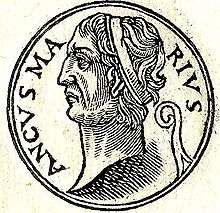Ancus Marcius
| Ancus Marcius or Martius | |
|---|---|
 Ancus Martius, fictional 16th-century depiction published by Guillaume Rouillé | |
| King of Rome | |
| Reign | 642–617 BC[1] |
| Predecessor | Tullus Hostilius |
| Successor | Lucius Tarquinius Priscus |
| Father | Marcius |
| Mother | Pompilia |
Ancus Marcius (c.677–617 BC ;[2] reigned 642–617 BC)[1] was the legendary fourth king of Rome. He was the son of Marcius (whose father, also named Marcius, had been a close friend of Numa Pompilius), who may be identified with Numa Marcius,[3] and Pompilia (daughter of Numa Pompilius).[4] According to Festus, Marcius had the surname of Ancus from his crooked arm. Upon the death of the previous king, Tullus Hostilius, the Roman Senate appointed an interrex, who in turn called a session of the assembly of the people who elected the new king.[4]
Ancus Marcius was believed by the Romans to have been the namesake of the Marcii, a Plebeian family.[5]
 | |
| O: diademed head of Ancus Marcius, lituus behind | R: equestrian statue on 5 arches of aqueduct (Aqua Marcia)
PHILIPPVS A-Q-V-A-(MAR) |
| Silver denarius struck by Lucius Marcius Philippus in Rome 56 BC. | |
First acts as King
According to Livy, his first act as king was to order the Pontifex Maximus to copy the text concerning the performance of public ceremonies of religion from the commentaries of Numa Pompilius to be displayed to the public, so that the rites of religion should no longer be neglected or improperly performed.[4]
War
He waged war successfully against the Latins, and a number of them were settled on the Aventine Hill.[6] According to Livy the war was commenced by the Latins who anticipated Ancus would follow the pious pursuit of peace adopted by his grandfather, Numa Pompilius. The Latins initially made an incursion on Roman lands. When a Roman embassy sought restitution for the damage, the Latins gave a contemptuous reply. Ancus accordingly declared war on the Latins. The declaration is notable since, according to Livy, it was the first time that the Romans had declared war by means of the rites of the fetials.[4]
Ancus Marcius marched from Rome with a newly levied army and took the Latin town of Politorium (situated near the town of Lanuvium) by storm. Its residents were removed to settle on the Aventine Hill in Rome as new citizens, following the Roman traditions from wars with the Sabines and Albans. When the other Latins subsequently occupied the empty town of Politorium, Ancus took the town again and demolished it.[6] The Latin villages of Tellenae and Ficana were also sacked and demolished.
The war then focused on the Latin town of Medullia. The town had a strong garrison and was well fortified. Several engagements took place outside the town and the Romans were eventually victorious. Ancus returned to Rome with much booty. More Latins were brought to Rome as citizens and were settled at the foot of the Aventine near the Palatine Hill, by the temple of Murcia. Ancus Marcius incorporated the Janiculum into the city, fortifying it with a wall and connecting it with the city by a wooden bridge across the Tiber,[7] the Pons Sublicius. On the land side of the city he constructed the Fossa Quiritium, a ditch fortification. He also built Rome's first prison, the Mamertine prison.[6]
He extended Roman territory to the sea, founding the port of Ostia, establishing salt-works around the port,[7] and taking the Silva Maesia, an area of coastal forest north of the Tiber, from the Veientes. He expanded the temple of Jupiter Feretrius to reflect these territorial successes.[6] According to a reconstruction of the Fasti Triumphales, Ancus Marcius celebrated at least one triumph, over the Sabines and Veientes.
Successor
Ancus Marcius was succeeded by Lucius Tarquinius Priscus who would later be executed by the sons of Ancus Marcius.[8] Patrician Marcius Rex -family is descended from Ancus Marcius and remained prominent during the republic and empire.
References
- 1 2 "Ancus Marcius" in The New Encyclopædia Britannica. Chicago: Encyclopædia Britannica Inc., 15th edn., 1992, Vol. 1, p. 379.
- ↑ Plutach's Parallel Lives vol. 1 p. 379
- ↑ E. Peruzzi Le origini di Roma I. La famiglia Firenze 1970 p. 142 ff.
- 1 2 3 4 Livy, Ab Urbe Condita, 1:32
- ↑ Niebuhr, The History of Rome, Volume 1, p. 301
- 1 2 3 4 Livy, Ab Urbe Condita, 1:33
- 1 2 Chisholm 1911.
- ↑ Livy, Ab Urbe Condita
- Attribution
 Chisholm, Hugh, ed. (1911). "Ancus Marcius". Encyclopædia Britannica (11th ed.). Cambridge University Press.
Chisholm, Hugh, ed. (1911). "Ancus Marcius". Encyclopædia Britannica (11th ed.). Cambridge University Press.
| Legendary titles | ||
|---|---|---|
| Preceded by Tullus Hostilius |
King of Rome 642–617 BC |
Succeeded by Lucius Tarquinius Priscus |
